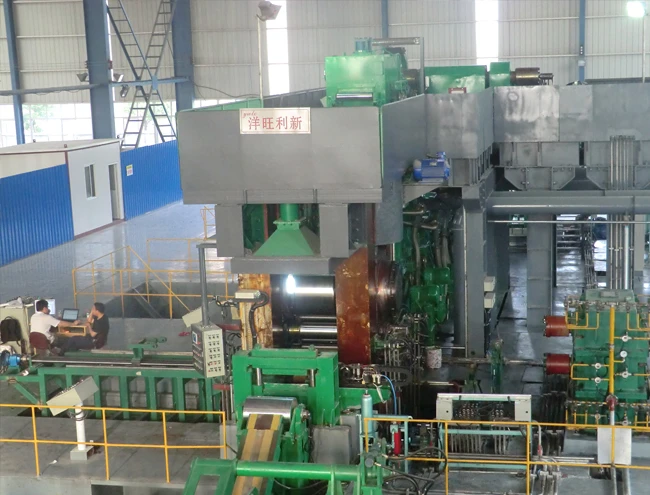
Roll Bonding Cladding for Anti-Corrosion, Cost Savings
Roll Bonding Cladding is a key solution in the manufacturing industry, specifically within Special Equipment Manufacturing Industry and Manufacturing of metallurgical specialized equipment. This article explores how Beijing Yang Wang Li Xin Sci&Tech Co.,Ltd. supports professionals with durable, high-performance products, and explains why this product is an ideal choice for businesses in these sectors.

Table of Contents
- Roll Bonding Cladding Overview
- Benefits & Use Cases of Roll Bonding Cladding in Manufacturing of metallurgical specialized equipment
- Cost, Maintenance & User Experience
- Sustainability & Market Trends in manufacturing
- Conclusion on Roll Bonding Cladding from Beijing Yang Wang Li Xin Sci&Tech Co.,Ltd.
Roll Bonding Cladding Overview
Roll Bonding Cladding is a solid-state metallurgical process that joins dissimilar metals—such as stainless steel, nickel alloys, titanium, or copper—to a carbon or low-alloy steel substrate through controlled rolling pressure and temperature. Compared with overlay welding, hot roll bonding cladding creates a uniform bond interface with minimal dilution, enabling the production of wide, long clad plates with predictable mechanical and corrosion-resistant performance. The process typically includes surface preparation, tight assembly, hot or warm rolling to induce plastic deformation and diffusion, followed by heat treatment and non-destructive testing to validate bond integrity.
- In metallurgical specialized equipment, clad plates produced by roll bonding are essential for pressure vessels, reactors, heat exchangers, and flue gas desulfurization units where corrosion, wear, and temperature resistance are critical.
- Technical setups commonly integrate precision surface treatment, high-reduction mills, accurate temperature control, and inline bond inspection (e.g., ultrasonic testing) to ensure consistent adhesion across plate width and length.
- Beijing Yang Wang Li Xin Sci&Tech Co.,Ltd. engineers cladding rolling mill solutions that help producers achieve stable bond quality, superior flatness, and high throughput—backed by application know-how specific to demanding metallurgical manufacturing environments.
Benefits & Use Cases of Roll Bonding Cladding in Manufacturing of metallurgical specialized equipment
For producers of metallurgical specialized equipment, Roll Bonding Cladding unlocks performance and cost advantages across multiple applications. Clad plates serve as a reliable feedstock for clad pipe welding in sour service pipelines, refinery and petrochemical equipment, and high-chloride environments in desalination. In steelmaking and nonferrous operations, corrosion-resistant liners in pickling lines, quench tanks, and furnace components benefit from the process’s strong metallurgical bond and predictable properties. Where large dimensions and tight flatness are required, hot roll bonding cladding offers repeatable quality and scalability not easily matched by manual or automatic overlay welding.
- Applications include pressure vessels, columns, heat exchangers, and tubing sheets in oil and gas, chemical processing, power generation, and mining—where lifetime reliability and corrosion resistance are paramount.
- Competitive advantages: consistent bond integrity, large-size capability, reduced alloy consumption versus solid alloy plates, and smoother downstream fabrication (cutting, forming, and welding).
- Beijing Yang Wang Li Xin Sci&Tech Co.,Ltd. supports end users with process optimization, line configuration, and automation that enhance productivity while maintaining strict quality benchmarks across cladding projects.
Cost, Maintenance & User Experience
Total cost of ownership is where Roll Bonding Cladding distinguishes itself. By combining a corrosion-resistant alloy layer with a cost-effective base steel, buyers can reduce alloy consumption significantly while meeting demanding service conditions. In addition, the roll-bonded route generally shortens fabrication cycles and mitigates rework risk compared with heavy overlay welding. Over the lifecycle of pressure vessels and process equipment, these savings translate into compelling ROI—especially when uptime and maintenance intervals are critical KPIs for operators.
- Durability and reliability: uniform bonding and controlled plate geometry reduce downstream defects, while proven inspection regimes support long service life in corrosive or high-temperature environments.
- User feedback from the Special Equipment Manufacturing Industry highlights stable product quality, ease of forming and welding during fabrication, and predictable performance in service—key factors for project risk reduction.
- Beijing Yang Wang Li Xin Sci&Tech Co.,Ltd. emphasizes maintainability of cladding rolling mills, offering training, spare parts, and technical support that help customers sustain high uptime and consistent first-pass yield.
Sustainability & Market Trends in manufacturing
Sustainability drivers—lower embodied carbon, resource efficiency, and extended equipment life—are accelerating adoption of Roll Bonding Cladding across global manufacturing. By using only a thin layer of expensive alloy on a robust base steel, producers minimize raw material intensity and energy demand compared with fabricating from solid alloy plate or extensive overlay welding. This approach aligns with decarbonization targets, ESG frameworks, and tightening environmental regulations across energy, chemicals, and mining supply chains.
- Growth segments include hydrogen and ammonia, carbon capture, LNG, desalination, and offshore projects—each requiring corrosion-resistant, high-reliability materials and robust bond quality.
- Beijing Yang Wang Li Xin Sci&Tech Co.,Ltd. supports eco-conscious manufacturing with energy-efficient drive systems, precise process control, and optional in-line inspection that reduces scrap. The company’s forward-thinking engineering helps customers meet sustainability goals while maintaining competitive cost structures and delivery timelines.
Conclusion on Roll Bonding Cladding from Beijing Yang Wang Li Xin Sci&Tech Co.,Ltd.
For B2B decision makers in the Special Equipment Manufacturing Industry and Manufacturing of metallurgical specialized equipment, Roll Bonding Cladding offers a proven path to performance, cost efficiency, and sustainability. From hot roll bonding cladding for large plates to feedstock supporting clad pipe welding, the approach consistently delivers high bond integrity and lifecycle value. Beijing Yang Wang Li Xin Sci&Tech Co.,Ltd. stands out for its engineering depth, application support, and commitment to quality and uptime.
- Partner with a trusted innovator in cladding rolling mill solutions to de-risk projects and accelerate your time to market.
- Contact us: email: Alley.wang@bjywlx.com
- Visit our website: https://www.bjywlx.com
-
YWLX’s 1450mm Six-Hi Reversing Mill Goes Live in BangladeshNewsNov.24,2025
-
Adjusting Roll Gap in 6Hi Reversing Cold Rolling Mill for Thin StripNewsNov.13,2025
-
Quality Control Standards for Automatic Gauge Control in Strip RollingNewsNov.13,2025
-
Effect of Skin Pass Rolling on Metal DuctilityNewsNov.13,2025
-
Key Components of a Modern TempermillNewsNov.13,2025
-
Common Wear Patterns of Work Roll in Tandem Cold Mill OperationsNewsNov.13,2025
-
Revolutionary Skin Pass Rolling Technology for Enhanced Steel QualityNewsNov.04,2025










